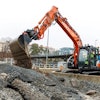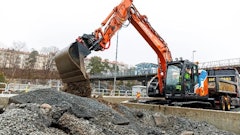Engineers designing construction and industrial equipment for U.S. OEMs need to consider the equipment rental market, as it remains an engine for growth with lots of runway remaining. In the midst of the usual fluctuations in construction, rental has maintained a steady growth trajectory which promises to continue for years to come.
By the numbers
In its most recent report, the American Rental Association (ARA) predicts equipment rental industry revenue growth in the U.S. of 6.7% in 2016 and 2017, 6.2% in 2018 and 5.8% in 2019, to reach a total volume of $48.7 billion.
The growth pace is slightly more moderate than the previous two years, when the compounded annual growth rate (CAGR) was closer to 7-8%, but the industry’s progress is consistently positive regardless of changes in oil and gas, construction and other segments equipment rental companies serve.
“The performance of the equipment rental industry since the recession has been very positive and as auxiliary industries recover and grow, we anticipate equipment rental revenue growth to meet the forecast of the next 5 years,” says Christine Wehrman, ARA CEO and Executive Vice President.
“This means equipment rental companies can prepare for steady growth, plan for expanding their markets and build inventory to meet their customer demand. The forecast also shows that many customers who have turned to renting equipment during and after the recession have seen the benefits and will continue to rent to control their costs,” Wehrman says. “The secular shift to rental is here to stay.”
Construction fuels growth
The economic analysis from the ARA Rental Market Monitor subscription service suggests the ongoing rebound in real residential construction in 2015 will help fuel growth in the construction and industrial equipment and the general tool rental segments.
“A 2015-19 compound annual growth rate of 2.7% is projected for real total construction with real nonresidential growing 1.0% and real residential growing 5.7%. This will drive revenue growth in the construction and industrial segment and the general tool segment, which will average annual revenue increases of 6.5% and 6.7% respectively, over the period,” according to the latest analysis provided by IHS Economics, the forecasting firm that provides data and analyses for the ARA Rental Market Monitor.
The effects of oil and gas
For the second year in a row, oil prices took a sharp downturn this fall, due in part to a glut of worldwide supply. Crude has dipped below $40 a barrel, as inventories continue to rise, and many analysts are skeptical of oil prices recovering in 2016.
Recovery is predicted over the long haul, however.
“Lower oil prices will put some downward pressure on oil sands investment, but prices are expected to bottom out above the point at which oil sands become unprofitable, and will rise steadily to over $80 a barrel by the end of 2018,” according to the ARA Rental Market Monitor.
Challenges to upstream petroleum operations aside, downstream work in refineries and with distribution show no signs of slowing. And for that, equipment is needed and much of that equipment is rented, particularly power generators, as well as larger boom lifts and telehandlers.
Regardless, the rental industry is exposed to the oil and gas industry and there has certainly been a reduction in that segment. Still, many operations remain well funded, and lower energy costs translate into improved consumer spending power and corporate profits, which can result in more projects and more potential rental revenue.
Rental penetration deepens
Activity in the construction and oil and gas sectors aside, contractors are renting more than ever before due to a relatively newfound awareness of the benefits of renting, including a cleaner balance sheet and no maintenance or insurance costs. Factor in increasing equipment ownership costs due to U.S. emissions regulations and the case for renting gets even stronger.
Construction/industrial rental penetration was up from 52.9% in 2013 to 53.9% for 2014, according to the ARA Rental Penetration Index. In other words, more than half of the equipment on today’s jobsites is rented, and the trend keeps pointing upward.
ARA’s Rental Penetration Index measures the proportion of the total fleet of construction machines that are owned by equipment rental companies. The index is value-based and uses original equipment cost as the primary weighting factor to calculate the ratio of rental equipment value to total fleet value.
Sales into the rental channel by equipment manufacturers also continue to grow, meaning the penetration rate could climb even higher into 2016. In addition, ARA is forecasting an increase of 8.3% in investment in equipment by rental companies this year.
Ever the bright spot
Even with question marks surrounding the oil and gas market, and the always cyclical nature of construction, equipment rental promises to remain a beacon of light on the economic horizon because construction professionals have discovered the benefits of renting and made what many believe is a permanent shift in that direction. Seasoned contractors realize that renting equipment allows them to acquire the precise piece of equipment needed and receive 24/7 customer service, all while conserving capital and eliminating the need for storage, maintenance, insurance, transportation and disposal costs.
This “paradigm shift” in the way construction professionals see equipment acquisition is evident in the way many of today’s equipment manufacturers are designing equipment. The past 2 years have seen the introduction of several “rental-specific” earthmoving machines designed with an eye toward faster return on investment with fewer premium features and a reduction of Tier 4-related concerns.
Forward-thinking OEMs will keep an eye on the rental market and continue to develop machines that meet the needs of today’s operators while earning equipment owners maximum returns.


















